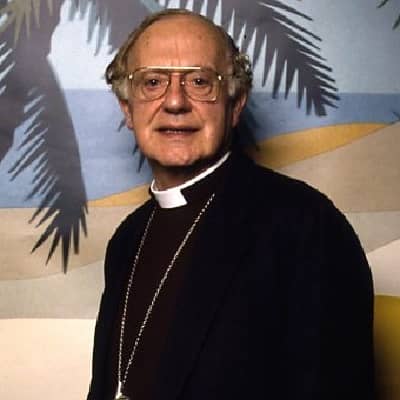Robert Runcie was an Anglican bishop in England. Robert Alexander Kennedy Runcie was born on October 2, 1921.
Table of Contents
Wiki, Bio, Family, Siblings, Childhood & Education
Robert Alexander Kennedy Runcie was born on October 2, 1921, in Birkenhead, Cheshire. His middle-class, non-religious parents raised him in Great Crosby, Lancashire.
Runcie first attended St. Luke’s Church in Crosby (where he was confirmed in 1936) before moving a mile away to St. Faith’s Anglo-Catholic Church. Robert received his schooling at Merchant Taylors’ Boys’ School in Crosby before moving to Brasenose College in Oxford.
When he returned to Oxford, he shocked many by achieving first-class honors in Greats. At Oxford, he was a member of the Conservative and Socialist parties. And he first met Margaret Thatcher when she was a young woman. (then Margaret Roberts). This meeting would be critical to his archiepiscopal term.
Robert Runcie’s Age, Height, Weight, and Body Dimensions
There is no information about his height, weight, dress size, waist size, or other physical characteristics. However, based on his photographs, we may presume he had brown eyes and a bald head.

Licensed Ministry
Instead of pursuing a second bachelor’s degree in theology, Runcie studied for ordination at Westcott House in Cambridge and received a diploma. He was chosen as a curate in the rich Newcastle parish of All Saints. After two years, Runcie was called back to Westcott House as chaplain and eventually vice-principal. In 1956, he was appointed fellow and dean of Trinity Hall in Cambridge, where he met Rosalind, the college bursar’s daughter and future wife.
In 1960, he returned to the world of theological colleges as principal of Cuddesdon College and vicar of the community church. Over the course of ten years, he transformed what had previously been a very hermit-like and Anglo-Catholic institution into a bulwark of the Church of England’s liberal Catholic history. During this period, his future as a bishop was hotly debated, and when he was named Bishop of St. Albans in 1970, the gossip was confirmed to be true.
In the 1950s, the Diocese of St. Albans was a thriving suburban location popular with families fleeing a declining London. In addition to his work with broadcasters as the head of the Central Religious Advisory Committee, he was chosen chairman of the combined Anglican-Orthodox Commission and engaged in diocesan work.
Canterbury, Archbishop of Canterbury
Ronald Runcie was chosen to succeed Donald Coggan as Archbishop of Canterbury in 1979, just as he was about to step down. There is evidence that Runcie was the Crown Appointments Commission’s second choice after Hugh Montefiore, who was deemed politically undesirable by the prior newly elected Conservative government. He was appointed archbishop on March 25, 1980.
During his tenure as Archbishop of Canterbury, he witnessed the once-close links between the Conservative (i.e., Tory) Party and the Church of England, dubbed “the Tory party at prayer,” fray.
The church’s political pronouncements, as well as Margaret Thatcher’s support for individualism and economic growth, were the primary causes of the collapse. And her statements in 1987 were misquoted as saying “there is no such thing as society,” when she had actually meant, “Who is society?'” Some Anglicans thought the phrase “There is no such thing!” was impolite and un-Christian. In 1981, Runcie officiated at the wedding of Charles, Prince of Wales, and Lady Diana Spencer.
More…
Faith in the City, a 1985 church report that critiqued how the government handled social concerns in British inner-city regions, produced a schism between the Church of England and members of the Conservative administration, particularly Norman Tebbit.
Tebbit, who believed that organizations related to the British state should refrain from expressing blatantly partisan political views, became a strong champion for the Church of England’s disestablishment.
Death and Retirement
Runcie resigned as Archbishop of Canterbury on January 31, 1991. On February 1, he was made a life peer, and on February 7, he was gazetted as Baron Runcie of Cuddesdon in the County of Oxfordshire.
This gave him the opportunity to return to the House of Lords, where he had previously served as a Lord Spiritual. He was laid to rest on the grounds of St. Albans Cathedral after dying of cancer there in 2000.
Robert Runcie’s Wife, Marriage & Relationship
Runcie was a happily married man. On the 5th of September 1957, he married Rosalind. His wife was a concert pianist. They were the parents of two children, author James Runcie and Rebecca Runcie. He also had four grandchildren, Rosie, Charlotte, Matthew, and Edward. He passed away on January 12, 2012.
Robert Runcie’s Salary and Net Worth
Robert was a prosperous bishop in his day. He could have made a good living during his career. He had not, however, disclosed his salary or net worth.
Robert Runcie’s Social Media(Facebook, Twitter, Instagram)
Social media was not widely used at the time. As a result, he avoided social media platforms such as Facebook, Instagram, and Twitter.
Quick Facts
| Full Name | Robert Runcie |
|---|---|
| Born Date | 02 Oct 1921 |
| Age | 101 years |
| Horoscope | Libra |
| Lucky Number | 7 |
| Lucky Stone | Peridot |
| Lucky Color | Blue |
| Best Match for Marriage | Gemini |
| Death Date | January 12, 2012 |
| Gender | Male |
| Profession | Bishop |
| Country | England |
| Marital Status | married |
| Married Date | September 5, 1957 |
| Wife | Rosalind |
| Eye Color | Black |
| Birth Place | Birkenhead, Cheshire |
| Religion | Christianity |
| Education | Merchant Taylors’ Boys’ School |
| Kids | 2 (James Runcie, Rebecca Runcie) |
| Wiki | Robert Runcie Wiki |
| Brands | N/A |
| Hobbies | N/A |

